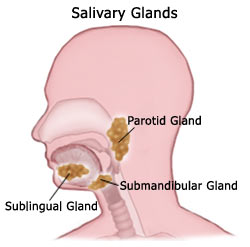 in humans, three pairs of glands that secrete the alkaline digestive fluid, saliva, into the mouth. Most animals have salivary glands that resemble those in humans; however, in some animals these glands perform other functions. For example, the salivary glands of many blood-sucking species secrete a substance that prevents blood coagulation.
in humans, three pairs of glands that secrete the alkaline digestive fluid, saliva, into the mouth. Most animals have salivary glands that resemble those in humans; however, in some animals these glands perform other functions. For example, the salivary glands of many blood-sucking species secrete a substance that prevents blood coagulation.
In humans the largest pair of salivary glands is situated just below and in front of each ear (parotid glands), the second pair is below the jaw (submandibular), and the third is under the tongue (sublingual). Ducts carry the secretions of the salivary glands into the mouth cavity. Together with the mucus secreted by the membrane of the mouth and the secretions of other small glands in the mouth, saliva helps to keep the mouth moist, softens the food as it is chewed, and by means of salivary amylase the digestive enzyme contained in saliva converts starch to sugar, thus initiating the process of digestion (see digestive system).
The flow of saliva is stimulated by the presence of food in the mouth, or even the sight and smell of food. A lack of salivary flow from a gland may be caused by the formation of a calculus, or mineral concretion, that blocks a duct. The parotid glands are subject to growths, usually benign, and to infection (see mumps).
Most animals have salivary glands that resemble those in humans; however, in some animals these glands perform other functions. For example, the salivary glands of many blood-sucking species secrete a substance that prevents blood coagulation. In humans the largest pair of salivary glands is situated just below and in front of each ear (parotid glands), the second pair is below the jaw (submandibular), and the third is under the tongue (sublingual). Ducts carry the secretions of the salivary glands into the mouth cavity. Together with the mucus secreted by the membrane of the mouth and the secretions of other small glands in the mouth, saliva helps to keep the mouth moist, softens the food as it is chewed, and by means of salivary amylase—the digestive enzyme contained in saliva—converts starch to sugar, thus initiating the process of digestion (see digestive system). The flow of saliva is stimulated by the presence of food in the mouth, or even the sight and smell of food. A lack of salivary flow from a gland may be caused by the formation of a calculus, or mineral concretion, that blocks a duct. The parotid glands are subject to growths, usually benign, and to infection (see mumps).






























